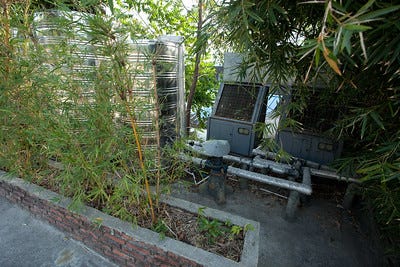Environmental Cents: Energy Efficient Construction
Geothermal heat pumps are not only more efficient than traditional heat pumps, they can produce substantial energy savings.
By Bruce Saller
COLUMNIST

As energy costs increase and the impacts of climate change grow, it is essential that schools and other buildings are constructed as energy efficiently as possible, Arlington County has been a leader in constructing energy efficient schools.
Discovery Elementary School uses 77% less energy per square foot than the average Arlington County school and is saving $100,000 per year on energy costs. Major energy-efficient features include:
100% LED lighting
Insulated concrete walls
Rooftop solar panels
More windows to increase natural lighting
Solar hot water
Geothermal heat pumps
A large portion of the energy savings comes from using geothermal heat pumps. Conventional heat pumps transfer heat between the inside and outside air. The efficiency of the transfer declines in winter as the outside temperature decreases.
Geothermal heat pumps transfer heat between the heat pump refrigerant and water circulating through underground wells. Since the water temperature is stable year-round (about 55 degrees in our area), the heat transfer in winter is much more efficient. In summer, the heat absorbed by the cool water provides most of the needed cooling. The Environmental Protection Agency estimates a geothermal heat pump uses 61% less energy than a conventional heat pump, with a payback period of 5 – 10 years.
These energy saving ideas should be considered in construction of government, commercial, retail and even residential developments. A mixed-use community in Kentucky (2,880 residences, 500,000 sq ft commercial) is only installing geothermal heat pumps. Besides saving energy, geothermal units are much quieter averaging 42 decibels (similar to a refrigerator) vs around 60 decibels for a conventional heat pump, providing a more enjoyable neighborhood.
Support the Advance with an Annual Subscription or Make a One-time Donation
The Advance has developed a reputation for fearless journalism. Our team delivers well-researched local stories, detailed analysis of the events that are shaping our region, and a forum for robust, informed discussion about current issues.
We need your help to do this work, and there are two ways you can support this work.
Sign up for annual, renewable subscription.
Make a one-time donation of any amount.
Local Obituaries
To view local obituaries or to send a note to family and loved ones, please visit the link that follows.
This article is published under Creative Commons license CC BY-NC-ND. It can be distributed for noncommercial purposes and must include the following: “Published with permission by FXBG Advance.”











Nice technology, but as seen here, works best at a larger scale. 2800 residences + 1/2 million of commercial space is about 25% of Fredericksburg. Not too many builders are developing projects of that scale around here.
By all means, yes - if the numbers work. But geothermal companies like Waterfurnace have tried for decades to break into the residential market, with little success except for those for whom money was a secondary consideration. To where they've now essentially abandoned it. They can't compete.
Not because their technology is bad, but because air source heat pumps, particularly minisplits, when correctly sized, ducted (or unducted), and installed - are delivering comparable performance with minimal upfront costs.
SEERs in the 20s, HSPF over 10. When just a few years ago, both were a 3rd less. At a fraction of the costs.
Granted, the market currently is not as honest as I would prefer, in that it ignores not only carbon pricing, but other hidden costs, such as long term damages such as black lung to miners, slave labor in foreign markets, etc.
But with thousands of dollars in upfront costs for well drilling, line installation, etc. - where those upfront costs do not deliver a return on investment such as a one lot home, I think the average consumer is done a disservice if those costs aren't noted along with the benefits when deciding.
For residences, a detailed Manual J to calculate the load, a Manual D to determine duct design, and a Manual S to correctly fit the equipment to the needs. Followed by installation by someone capable of correctly putting it all together, along with the other needed factors in a well designed home, such as a true ventilation system, appliances, lighting, air sealing, and insulation.
In other words, a whole system approach.
Geothermal might work best in such a system. If so, go for it.
But it might not. Do the assessment first, then give the purchaser the information based upon that assessment to objectively decide what solution works best for them.
Average consumers who are given promises of performance without context will quickly grow frustrated and distrustful if given anything else. Which does no one looking for improvement any good.